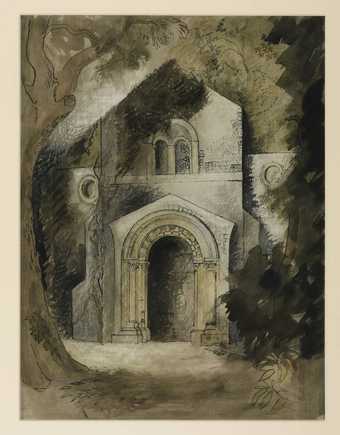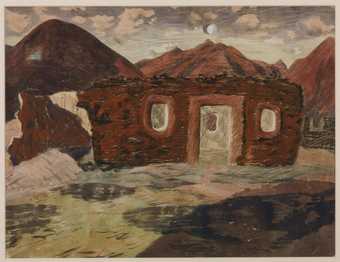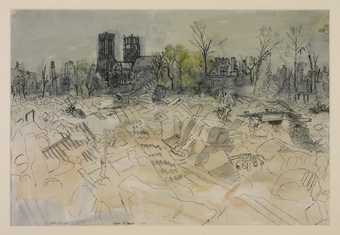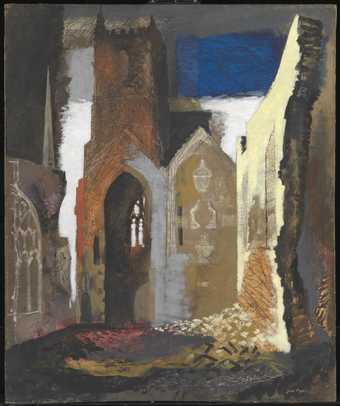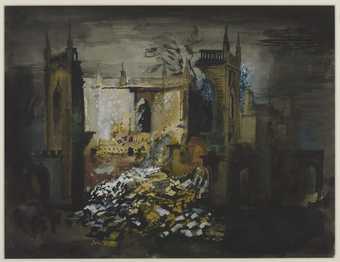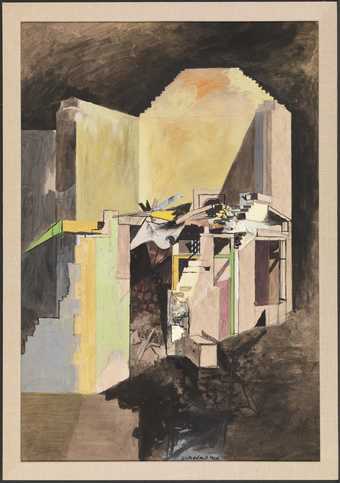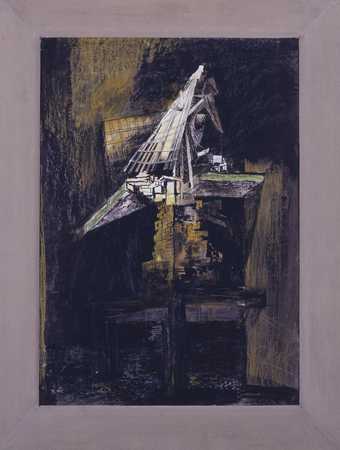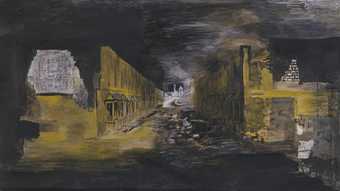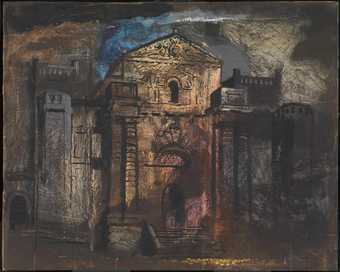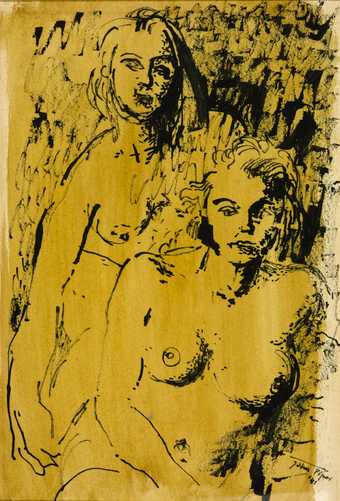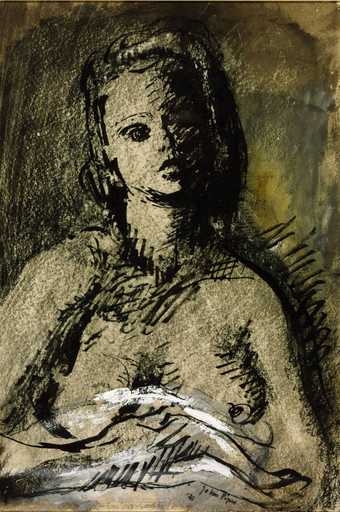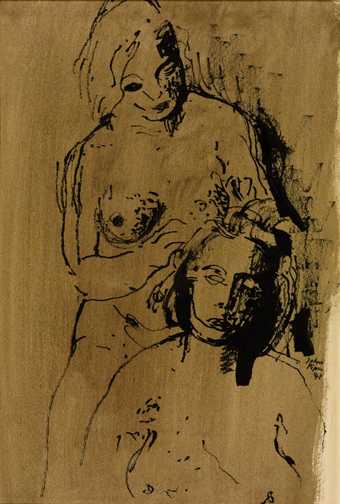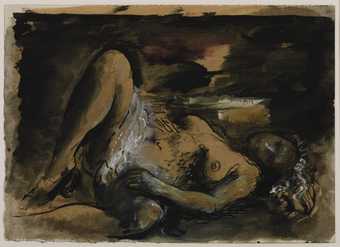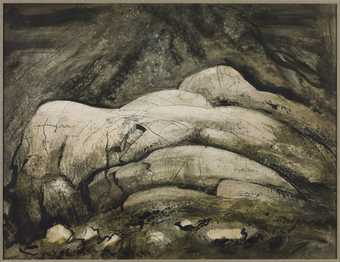
Not on display
- Artist
- John Piper 1903–1992
- Medium
- Graphite, ink and gouache on paper
- Dimensions
- Support: 489 × 762 mm
frame: 707 × 976 × 25 mm - Collection
- Tate
- Acquisition
- Presented by the War Artists Advisory Committee 1946
- Reference
- N05720
Display caption
In 1942 Piper was suddenly sent to Bath following three nights of bombing there. He worked while the buildings were still burning. Reviewing an exhibition of war art at the National Gallery in October 1941 Piper wrote, 'after a war the controlled emotional record of actual events - the record made at once from experience and in the heat of the moment - is the only one that counts'. The watercolours he made in Bath provided the occasion for making such a record. They are the first to achieve the theatrical lighting effects typical of his work.
Gallery label, August 2004
Does this text contain inaccurate information or language that you feel we should improve or change? We would like to hear from you.
Catalogue entry
Somerset Place, Bath 1942
Pencil, ink and gouache on Whatman paper
489 x 760 (19 1/4 x 29 15/16)
Inscribed in black ink 'John Piper' b.l.
Watermark 'J WHATMAN' along bottom edge
Printed War Artists Advisory Committee label, no. 1975
Presented by the War Artists Advisory Committee 1946
Exhibited:
?National War Pictures, National Gallery, London 1942-3 (changing display, no cat.)
War Pictures, 4th Selection, Museums' Association tour 1943-4, Harris Museum and Art Gallery, Preston, Jan. 1943, Oldham Municipal Art Gallery, Feb., Bankfield Museum, Halifax, March-April, Graves Art Gallery, Sheffield, May, Mansfield Museum & Art Gallery, June, Stoke-on-Trent Public Museum & Art Gallery, July, Wolverhampton Municipal Museum & Art Gallery, Aug.-Sept., Hereford Public Library, Museum & Art Gallery, Sept.-Oct., Victoria Art Gallery, Bath, Oct.-Nov., Bristol Museum & Art Gallery, Dec. 1943-Jan. 1944 (no cat.)
War Pictures, 4th Selection, National Gallery, London, June 1944 (no number, repr. [p.4.] as Centre of Somerset Place)
National War Pictures, Glasgow City Art Galleries, May-June 1945 (no cat.)
National War Pictures, Royal Academy, London, Oct.-Nov. 1945 (223)
Modern British Pictures from the Tate Gallery, British Council tour, 1946-7, Palais des Beaux-Arts, Brussels, Jan.-Feb. 1946 (66), Stedelijk Museum, Amsterdam, March (66), Raadhushallen, Copenhagen, April-May (66), Musée de Jeu de Paume, Paris, June-July (66), Musée des Beaux Arts, Berne, Aug. (67), Akademie der Bildenden Kunste, Vienna, Sept. (68), Narodni Galerie, Prague, Oct.-Nov. (68), Muzeum Narodne, Warsaw, Nov.-Dec. (68), Galleria d'Arte Moderna, Rome, Jan.-Feb. 1947 (68, as Lansdowne Crescent Seen from the Ruins of Lansdowne Chapel, Bath)
Continental Exhibition: Modern British Pictures from the Tate Gallery Exhibited Under the Auspices of the British Council, Tate Gallery, London, May-Sept.1947; publication supplemented as Fifty Years Tate Gallery 1897-1947: Pictures from the Tate Gallery Foundation Gift and Exhibition of Subsequent British Painting, (no number)
Modern British Pictures from the Tate Gallery, Arts Council tour 1947-8, Leicester Museum and Art Gallery, Sept.-Oct.1947, Graves Art Gallery, Sheffield, Oct.-Nov., Birmingham City Museum and Art Gallery, Nov.-Dec., Birkenhead, Williamson Art Gallery, Jan.1948, Bristol City Art Gallery, Jan.-Feb. 1948, Russell-Cotes Art Gallery, Bournemouth, Feb-March, Brighton Art Gallery and Museum, March-April, Plymouth City Art Gallery, April-May, Castle Museum, Nottingham, May-June, Huddersfield Museum and Art Gallery, June-July, Aberdeen Art Gallery, July-Aug., Salford Art Gallery and Museum, Aug.-Sept. (46, as Lansdowne Crescent Seen from the Ruins of Lansdowne Chapel, Bath)
John Piper, Tate Gallery, London, Nov. 1983-Jan. 1984 (58)
World War II, Tate Gallery Liverpool, Sept.-Nov. 1989 (55)
Literature:
Edith Hoffman, 'John Piper by John Betjeman', Burlington Magazine, vol.88, Jan. 1946, p.25
Mary Chamot, Dennis Farr and Martin Butlin, Tate Gallery: The Modern British Paintings, Drawings and Sculpture, II, London 1965, p.523
John Rothenstein, The Tate Gallery, London 1958, p.114, repr. in col. p.115
John Rothenstein, The Tate Gallery, London 1962, p.134, repr. in col. p.135
Peter Fuller, 'John Piper: Neo-Romanticism in the 1980s', Modern Painters, vol.1, no.2, Summer 1988, pp.17-19, repr. p.18
'John Piper: Obituary', Daily Telegraph, 30 June 1992, p.20
Also reproduced: John Betjeman, John Piper, Harmondsworth 1944, pl.19 (col.)
Eric Newton, War through Artists' Eyes, London 1945, p.78
John Rothenstein, The Tate Gallery, London 1958, p.115 (in col.)
Michael McNay, 'An End to Dull Theory', Design, no.253, Jan. 1970, p.104
William Gaunt, A Concise History of English Painting, London 1964, p.243, pl.199 (in col.)
Grey Gowrie, 'The Twentieth Century', David Piper (ed.), The Genius of British Painting, London 1975, p.326
Boris Ford (ed.), Cambridge Guide to the Arts: Vol. 8 The Edwardian Age and the Inter-War Years, London 1989, p.180
Piper's paintings of Bath were made as one of his commissions from the War Artists Advisory Committee and followed the German bombing of the city on the nights of 25, 26 and 27 April 1942. The attacks became known as the Baedeker raids, because the targets were cultural rather than strategic and were said to be selected from the pre-war Baedeker guide books. The artist was sent to Bath three days after the bombing ceased (E.M. O'Rourke Dickey, letter to Piper, 30 April 1942, Board Correspondence, Imperial War Museum), and later recalled: 'I think I went on 30th - there was certainly a hurry, I remember, and (again) ruins were still smouldering and bodies being dug out' (letter to Tate Gallery, 15 July 1958). He sketched in the Lansdown area, in the north-western heart of the Georgian city, where the damage was greatest and produced finished works from the sketches by 13 May.
Somerset Place was built around 1790 by John Eveleigh as part of the Georgian developments; it runs on from, and is contemporary with, Lansdown Crescent, the site of All Saints Chapel. Piper's large watercolour Somerset Place was even more sober than the stricken All Saints Chapel, Bath
(N05719), showing the buildings bleached and ghostly. A surviving ink and watercolour sketch Somerset Place, Bath, (after bombing) (repr. John Piper: Gouaches, Watercolours, exh. cat., Hamet Gallery, London 1969, no.4 on cover) established the characteristics of the image: the elevated viewpoint, the sweep of the crescent, the contrast between the apparently ordinary buildings to the right and the hole at the left. The final watercolour reused the gaping rear elevation seen through the building, and the cracked facade and diagonally sheared-off window. The two windows flanked by doors in the sketch were reduced to a single window and a broad doorway, this had the effect of enhancing the dramatic contrast between the hole and the elegant architecture.
Somerset Place was painted on good quality watercolour paper (cream wove) which Piper had stretched on board using brown tape, strips of which remain around the irregularly cut edges. The washed treatment of the grey-green sky is consistent with the soaked paper, over which some architectural details were fixed in pale yellow gouache and black ink to follow visible pencil underdrawing (Tate Gallery conservation files). This included a line continuing the curve of the buildings across the broken space - emphasising the loss - and allowed the suggestion of the regular windows in the facade without laborious delineation. The offset hole is the focus, dramatised by the suggestive splatter of red. It is balanced by the fragile white balcony and by the more sketchy open segmental pediment. The latter was the subject of Centre of Somerset Place
(Manchester City Art Gallery, repr. Neo-Romantics: Drawings and Watercolours, exh. cat. Imperial War Museum, London 1981, no.19), in which it is more obvious that the whole terrace was burnt out.
The WAAC were pleased with the results and it is likely that both paintings subsequently given to the Tate joined the changing display of 'War Pictures' at the National Gallery. Their propaganda value was demonstrated by the explanation accompanying Somerset Place in the fourth War Pictures by British Artists selection (June 1944, [p.6]): 'John Piper ... went to Bath to record the affect of the brutal bombing of this lovely city by the frustrated Nazis out of revenge for the British attacks on German war factories. Here he has recorded how a beautiful eighteenth-century building has been marred by the savage onslaught.' After the war the WAAC distributed their paintings to public galleries; Somerset Place was restored as the Art School. Significantly, Piper's sympathetic record of the buildings was seen by Fuller as anticipating the architectural debate between development and conservation in the 1980s (Fuller 1988, pp.17-19).
Note:
General issues relating to Piper's work in Bath are discussed in the entry on All Saints Chapel, Bath
(Tate Gallery N05719).
Matthew Gale
August 1996
Explore
- architecture(30,960)
-
- periods and styles(5,198)
-
- Georgian(255)
- ruins(3,711)
-
- bomb damage(78)
- townscapes / man-made features(21,603)
-
- street(1,623)
- universal concepts(6,387)
-
- destruction(383)
- military: World War II(1,269)
-
- air raid(59)
- Baedeker Raids, Apr 1942(2)
- England(19,202)
You might like
-
John Piper The Dairy, Fawley Court
1940 -
Edward Bawden Burnt Tukl at Gubba
1941 -
John Piper St Mary le Port, Bristol
1940 -
John Piper All Saints Chapel, Bath
1942 -
Graham Sutherland OM Devastation, 1940: A House on the Welsh Border
1940 -
Graham Sutherland OM Devastation, 1941: East End, Wrecked Public House
1941 -
Graham Sutherland OM Devastation, 1941: An East End Street
1941 -
Graham Sutherland OM Devastation, 1941: East End, Burnt Paper Warehouse
1941 -
John Piper Seaton Delaval
1941 -
John Piper Figure Drawing
1941 -
John Piper Figure Drawing
1941 -
John Piper Figure Drawing
1941 -
John Piper Nude
1942 -
John Piper Glaciated Rocks, Nant Ffrancon
1944

